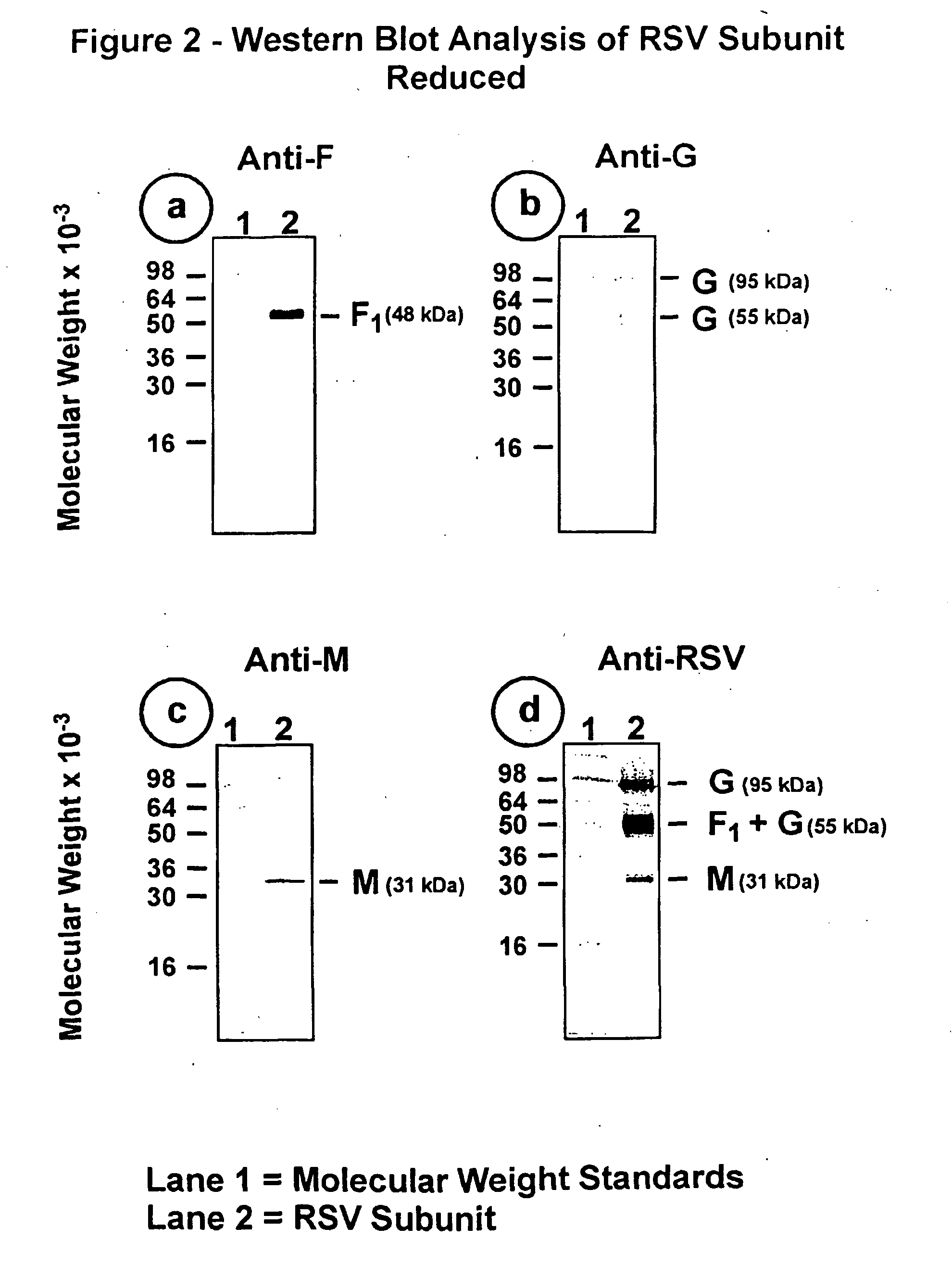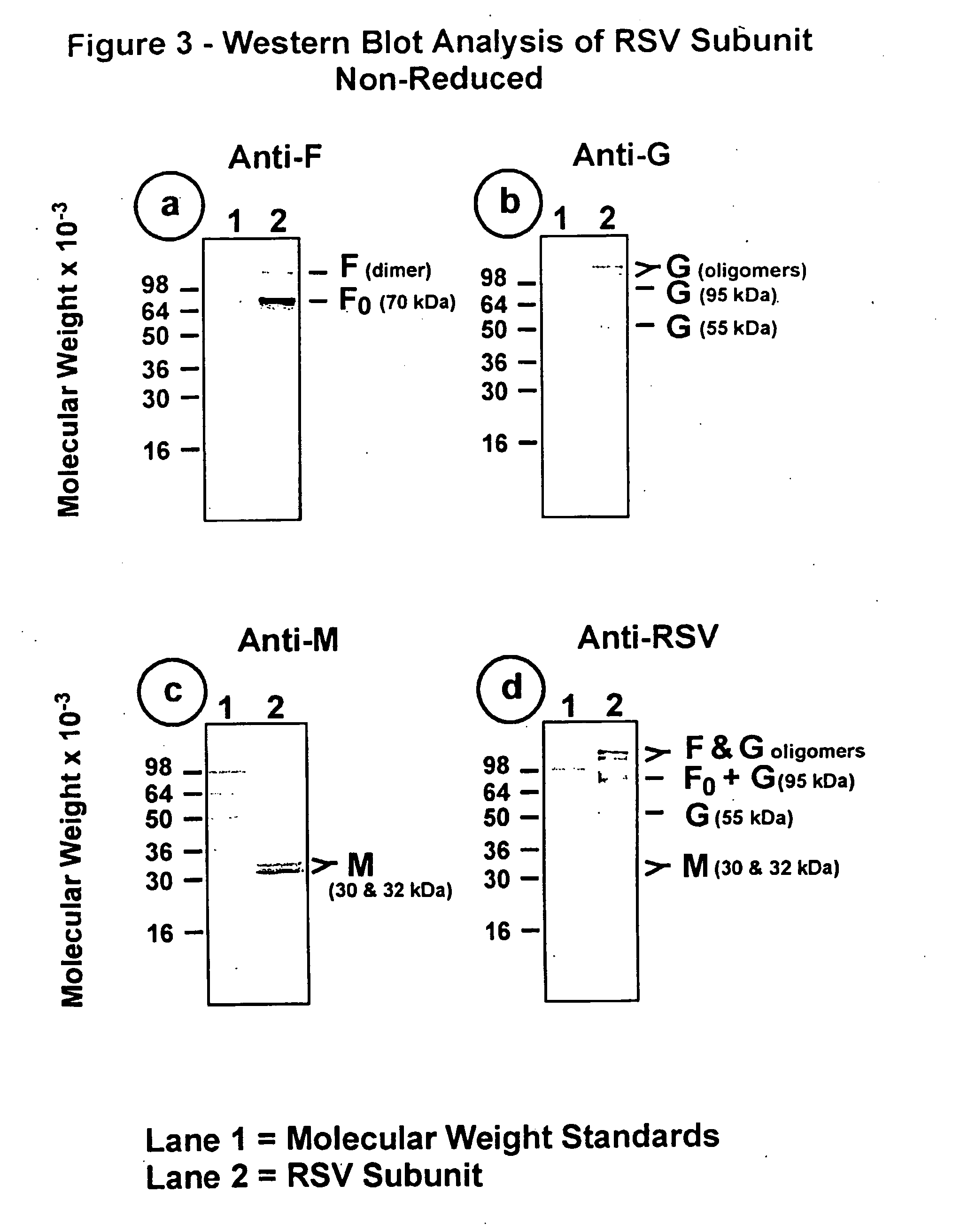Subunit respiratory syncytial virus vaccine preparation
a technology of respiratory syncytial virus and subunit, applied in the field of immunology, can solve the problems of clinical morbidity, genetic instability and overattenuation, and the inability of both live attenuated and formalin-inactivated vaccines to adequately protect vaccines against rsv infection
- Summary
- Abstract
- Description
- Claims
- Application Information
AI Technical Summary
Benefits of technology
Problems solved by technology
Method used
Image
Examples
example 1
[0090] This Example illustrates the production of RSV on a mammalian cell line on microcarrier beads in a 150 L controlled fermenter.
[0091] Vaccine quality African green monkey kidney cells (VERO) at a concentration of 105 cells / mL were added to 60 L of CMRL 1969 medium, pH 7.2 in a 150 L bioreactor containing 360 g of Cytodex-1 microcarrier beads and stirred for 2 hours. An additional 60 L of CMRL 1969 was added to give a total volume of 120 L. Fetal bovine serum was added to achieve a final concentration of 3.5%. Glucose was added to a final concentration of 3 g / L and L-glutamine was added to a final concentration of 0.6 g / L. Dissolved oxygen (40%), pH (7.2), agitation (36 rpm), and temperature (37° C.) were controlled. Cell growth, glucose, lactate, and glutamine levels were monitored. At day 4, the culture medium was drained from the fermenter and 100 L of E199 media (no fetal bovine serum) was added and stirred for 10 minutes. The fermentor was drained and filled again with 12...
example 2
[0094] This Example illustrates the process of purifying RSV subunit from a viral concentrate of RSV subtype A.
[0095] A solution of 50% polyethylene glycol-8000 was added to an aliquot of virus concentrate prepared as described in Example 1 to give a final concentration of 6%. After stirring at room temperature for one hour, the mixture was centrifuged at 15,000 RPM for 30 min in a Sorvall SS-34 rotor at 4° C. The viral pellet was suspended in 1 mM sodium phosphate, pH 6.8, 2 M urea, 0.15 M NaCl, stirred for 1 hour at room temperature, and then recentrifuged at 15,000 RPM for 30 min. in a Sorvall SS-34 rotor at 4° C. The viral pellet was then suspended in 1 mM sodium phosphate, pH 6.8, 50 mM NaCl, 1% Triton X-100 and stirred for 30 minutes at room temperature. The insoluble virus core was removed by centrifugation at 15,000 RPM for 30 min. in a Sorval SS-34 rotor at 4° C. The soluble protein supernatant was applied to a column of ceramic hydroxyapatite (type II, Bio-Rad Laboratorie...
example 3
[0096] This Example illustrates the analysis of RSV subunit preparation obtained from RSV subtype A by SDS polyacrylamide gel electrophoresis (SDS-PAGE) and by immunoblotting.
[0097] The RSV subunit composition prepared as described in Example 2 was analyzed by SDS-PAGE using 12.5% acrylamide gels. Samples were electrophoresed in the presence or absence of 2-mercaptoethanol. (reducing agent). Gels were stained with silver stain to detect the viral proteins (FIG. 1, panels a and b). Immunoblots of replicate gels were prepared and probed with a mouse monoclonal antibody (mAb 5353C75) to F glycoprotein (FIGS. 2, panel a and 3, panel a), or a mouse monoclonal antibody (mAb 131-2G), to G glycoprotein (FIGS. 2, panel b and 3, panel b) or guinea pig anti-serum (gp178) against an RSV M peptide (peptide sequence: LKSKNMLTTVKDLTMKTLNPTHDIIALCEFEN-SEQ ID No:1) (FIGS. 2, panel c and 3, panel c), or goat antiserum (Virostat #0605) against whole RSV (FIGS. 2, panel d and 3, panel d). Densitometri...
PUM
| Property | Measurement | Unit |
|---|---|---|
| molecular weight | aaaaa | aaaaa |
| molecular weight | aaaaa | aaaaa |
| molecular weight | aaaaa | aaaaa |
Abstract
Description
Claims
Application Information
 Login to View More
Login to View More - R&D
- Intellectual Property
- Life Sciences
- Materials
- Tech Scout
- Unparalleled Data Quality
- Higher Quality Content
- 60% Fewer Hallucinations
Browse by: Latest US Patents, China's latest patents, Technical Efficacy Thesaurus, Application Domain, Technology Topic, Popular Technical Reports.
© 2025 PatSnap. All rights reserved.Legal|Privacy policy|Modern Slavery Act Transparency Statement|Sitemap|About US| Contact US: help@patsnap.com



